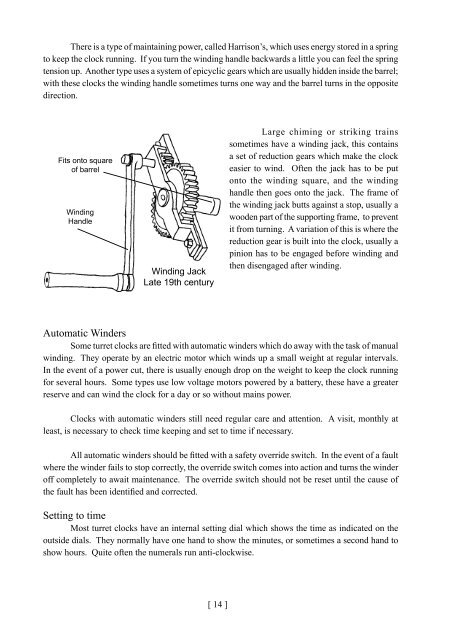You also want an ePaper? Increase the reach of your titles
YUMPU automatically turns print PDFs into web optimized ePapers that Google loves.
There is a type of maintaining power, called Harrison’s, which uses energy stored in a spring<br />
to keep the clock running. If you turn the winding handle backwards a little you can feel the spring<br />
tension up. Another type uses a system of epicyclic gears which are usually hidden inside the barrel;<br />
with these clocks the winding handle sometimes turns one way and the barrel turns in the opposite<br />
direction.<br />
Fits onto square<br />
of barrel<br />
Winding<br />
Handle<br />
Winding Jack<br />
Late 19th century<br />
Large chiming or striking trains<br />
sometimes have a winding jack, this contains<br />
a set of reduction gears which make the clock<br />
easier to wind. Often the jack has to be put<br />
onto the winding square, and the winding<br />
handle then goes onto the jack. The frame of<br />
the winding jack butts against a stop, usually a<br />
wooden part of the supporting frame, to prevent<br />
it from turning. A variation of this is where the<br />
reduction gear is built into the clock, usually a<br />
pinion has to be engaged before winding and<br />
then disengaged after winding.<br />
Automatic Winders<br />
Some turret clocks are fitted with automatic winders which do away with the task of manual<br />
winding. They operate by an electric motor which winds up a small weight at regular intervals.<br />
In the event of a power cut, there is usually enough drop on the weight to keep the clock running<br />
for several hours. Some types use low voltage motors powered by a battery, these have a greater<br />
reserve and can wind the clock for a day or so without mains power.<br />
<strong>Clock</strong>s with automatic winders still need regular care and attention. A visit, monthly at<br />
least, is necessary to check time keeping and set to time if necessary.<br />
All automatic winders should be fitted with a safety override switch. In the event of a fault<br />
where the winder fails to stop correctly, the override switch comes into action and turns the winder<br />
off completely to await maintenance. The override switch should not be reset until the cause of<br />
the fault has been identified and corrected.<br />
Setting to time<br />
Most turret clocks have an internal setting dial which shows the time as indicated on the<br />
outside dials. They normally have one hand to show the minutes, or sometimes a second hand to<br />
show hours. Quite often the numerals run anti-clockwise.<br />
[ 14 ]

















